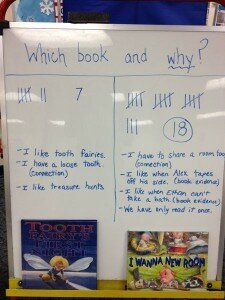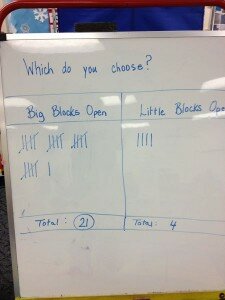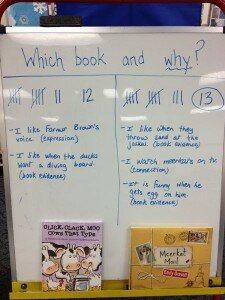We are in the middle of our opinion writing unit. In my district we have decided to have kindergartners focus on sharing opinions about books, and the kids are meant to do it in the form of letters. There are lots of lessons that are required for this, but I find that the most important is to get kids to begin to support their opinions with some sort of reasoning or evidence.
I want to share a simple and authentic way that I have been using in my class to encourage my kids to use support for their opinions. We often take votes in class. Sometimes I have the kids vote on whether they want big blocks or little blocks open during free play. We might vote on which game we are going to play as part of our morning meeting. We might vote on whether we want a longer indoor recess, or a longer outdoor recess. I think voting is an important part of running a democratic class, and it helps kids to understand both how to have an opinion, and that their vote does not always win. We start voting early in the year, and I make sure to periodically hold a vote to keep the kids in practice. Our method is simple: I write the two options on the board and have the kids think of their choice. I then call on kids one at a time to tell me their choice, and I make tally marks on the board. We then count together and determine the winner.
Once we get to our opinion writing unit, I change the voting process slightly. Everything is the same, with one simple addition. Now, when kids tell me their choice they must also tell me why. For example, before they might just say “big blocks.” Now they would have to say, “I choose big blocks because I like building houses that I can fit in.” Before they might say, “outdoor recess,” whereas now they would have to say, “I choose outdoor recess because I want to get some fresh air.”
This simple change is huge in terms of helping kids understand how to support their opinions. Once they get used to this (after one or two votes), they are ready for me to take things one step further. Since my kids are ultimately going to have to write letters that contain their opinions about books, I begin to have my kids vote on which book they would like me to read aloud. Once again they must tell the class their choice and why.
This process is wonderful because the kids naturally use a wide variety of evidence. Last week I asked my kids to vote between reading “I Wanna New Room” and “Tooth Fairy’s First Night.” Without any additional prompting other than that they needed to use the word “because,” these were some answers I got:
“I choose “I Wanna New Room” because I like the part when Alex tapes up his brother’s side of the room.”
“I choose “I Wanna New Room” because I have to share a room just like Alex does.”
“I choose “Tooth Fairy’s First Night” because I have a wiggly tooth right now.”
“I choose “I Wanna New Room” because we have only read it one time, and we have read the other book twice.”
“I choose “I Wanna New Room” because I like the part when Alex’s little brother can’t get out of the room to take a bath because the door is on Alex’s side of the room.”
These were all genuine responses which I was able to teach from. My kids naturally came up with personal connections, specific examples from the books, and even comparative strategies to help them make their opinions. Ultimately I want my kids to learn how to cite specific evidence and back their opinions up with worldly and personal reasons in their writing, and here they are doing it!
It is always incredible to see how small, simple changes like this can create powerful teaching. How do you help your kids support their opinions?




I imagine that I would have a couple of children in my class (I am imagining them now!) who would be able to tell me their choice but would always say, “I don’t know,” when asked to tell why. Several more might repeat the answer of a popular classmate, setting of a chain of myna birds. Have you encountered this? What have (or would) you do in those cases to encourage them to be able to thoughtfully form and articulate their own opinions?
Great question. Sometimes I do see those issues, although not often. One thing that helps is doing this routine over time. The kids begin to get used to it, and they know that they need to have an answer when it is their turn.
There are some things to do to help. First, you can determine the order in which you call on kids to vote. If you are concerned that many kids will copy “popular” kids, then call on the “popular” kids last. Or, if you are worried that some kids will not know what to say, wait until the end to call on them. Some children will naturally get how to do this, and they will run with it. Some children will simply not have the language or confidence right away. By letting them listen to examples given by their peers, they will begin to build up some of that knowledge, and they will know that it is safe to have an opinion. They may copy friends, but that is fine for a while. One day, after hearing lots and lots of examples, they will be ready to state their own opinion.
Finally, the teacher response is very important. For example, as soon as someone states a new and different opinion, I gently praise it. “Oh, _____ came up with a new idea that I haven’t heard before!” Or, “______, did you realize that you used an example from the book to support your opinion? That is just what I wanted to teach the kids! You must have read my mind.” When the other children hear this sort of noticing and praise, they will clamor to get it themselves. All of a sudden you will get LOTS of variety.
And, when you do a summery like I did on the board, it reinforces different types of evidence. This review sets kids up for what to do the next time you vote. Hope that helps!
I like that you give the more hesitant children so much support. It probably helps that this unit comes mid-year after having the children for so long in a nurturing environment already. I’ve noticed that my most reserved student is finally coming out of his shell just in the past month, and my “followers” are feeling strong enough to take the lead at times while the leaders share different roles, too. I just started teaching opinion writing last week, but did most of my writing support in small groups. We are going to write about favorite Dr. Seuss books this coming week, and I am going to use your whole-group approach to see what that kind of thinking that sparks – thank you for the ideas!
My pleasure – let me know how it goes!
Update: We made a chart to vote on which book to read, Green Eggs and Ham or Hop on Pop, and the children had to tell me why they wanted to hear that book again. Many answers were similar (because “it’s funny”), but some were very thoughtful (“it had different kinds of rhyming than the other stories,” “the bee part was really weird but I liked it,”). The next day, we used a graphic organizer to begin to write paragraphs stating our favorite books, why we liked them, the “best” parts, and a recommendation to read the book. Take that CCSS! Your chart was an awesome way to differentiate between why they liked the book and what their favorite part was, and to initiate some deeper thinking. Thank you! (still, I wish we didn’t have to do this in kindergarten :'( )
Awesome! Thanks for the update. I know what you mean though…. it is a lot for little kids. However, our job now is to make it as appropriate as we possibly can for their age, and it sounds like you did a great job!
Love this idea. I can’t wait to try something similar with my class–I think they will just love it. Making connections and having a choice!
-Lovely Nina